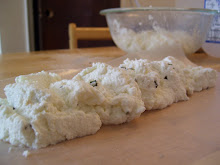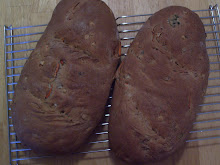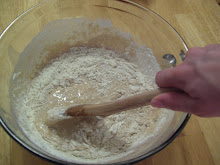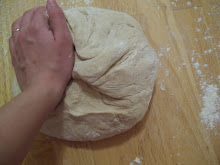Upon my decision to never set foot into a large chain grocery store I have been thinking about how bizarre and curious the dominant view of purchasing food is. It seems that typically once a week someone in the household has to run errands. The errands include trips, made as short and convenient as possible, to assorted destinations to the surrounding environs armed with a list and a car. The car is what necessitated the invention of the shopping cart. When people had a trunk to fill with food, the amount of food purchased at the store grew beyond the limits of the basket and into the ridiculous bounty of the grocery cart.
The purchaser thinks mostly in terms of what will last for a week or two so the person can avoid having to run more errands (errands are run, never walked; apparently if you want to walk you should get a dog). Therefore, the things that are purchased at the store are often in one of the following states: frozen, canned, or jarred, and all will last for an indefinite period of time. Even milk, with its ultra-pasteurization, will last for about two months from the day it’s bought (mind you, it’s been stored for about four months before hitting the shelves).
These items taste horrible, could easily be prepared from fresh or stored ingredients within the home, and contain harmful chemicals and preservatives that negate most nutritional value of the food eaten. For the most part shoppers purchase things that are fast and easy to prepare, since most people work 40 or more hours a week and view cooking as yet another chore in a seemingly endless list of errands and chores. These fast and easy meals are often individually packaged, packaged in a layer of plastic which is contained in a cardboard box. The shopper does not have to worry about this excessive packaging since the room in the trunk is ample and trash is taken away each week. There is no cue to consider the amount of energy consumed needlessly in the production of a mass market food item. No cue to look at the ingredients, after all if we all are dieting than all that matters is the fat percentages, right? Even the grocery store itself, the very environment where the shopper is present, is not something to be reconsidered for most. After all, all the big box stores are nearly the same. Just the status quo supermarket. Rows and rows of food items (not real food necessarily, but food products in boxes and bags marketed like new computer devices), frozen food sections made up of three aisles, many (oh, probably 16) check-out lines with scanners and registers, and open refrigerator cases lining the walls.
Quite possibly the only thing that will make the shopper pause, and only very few shoppers at that, is whether or not the food purchased is organic. It could be a frozen dinner contained in feet of plastic and cardboard packaging with ingredients grown in
I suppose, in a way it is a little better. Organic is indeed a good choice. Avoiding chemicals that are detrimental to the health of the eater, farmers who use the chemicals, and the earth is of course a choice that is in my view necessary and good.
But, what else is happening in this trip to the grocery store? Waste is everywhere. The car used to get to the grocery store uses petroleum both in gasoline and in its very construction. The store consumes tons of energy and typically uses gross amounts of land for the preposterous size of the store itself and the concrete parking lot that surrounds it (planted with small trees, often unhealthy and with short life spans). The store is more often than not a chain store. The workers are paid minimum wage and are in a situation where there is little or no opportunity to learn or exhibit skill regarding food. Even butchers would be more accurately called meat slicers. Most of the food in the grocery store barely resembles real food. The food with any real ingredients (let’s say carrots, or bananas, or beef) are so full of pesticides, preservatives, and hormones that speed up, fatten, ward off insects and disease in the most harmful and unnatural way to all living things involved in the process – eater, farmer, and plant or animal. The only beneficiary in the process is the petro-chemical industry that manufactures most pesticides (yes, another petroleum derivative. Amazing how much relies on a waning natural resource), the drug companies that prevent the death of all industry raised animals who are deathly ill from being fed grains and kept in unnatural habitats, and the food manufacturers who pump out food as if it were an assembly line factory pumping out products, brimming with marketing strategies. This stuff isn’t food. It more likely resembles a Tyco plastic toy than a meal.
And finally, there is the context of buying this “food.” It is bought as a commodity. It is even worse than shopping for Christmas. The highest quality of work that has gone into this food is the efforts toward marketing the item – designing the package, writing the catchy ad and jingle, getting a celebrity, and making people reliant on the convenience of preparation rather than their own skills in the kitchen (is there any left?). Most of the people that have touched the food item (has it even been touched or does it only know machines?) know little to nothing about the food – does it taste good, how to prepare it, during which season does it grow. This makes me wonder why the family psychologists even care if the family sits down to one dinner a week together? Can this rightly be called a dinner? Is this the kind of thing that should be shared with loved ones?
So, I am sure you are asking, what is the alternative? Well, the alternative is not enough. An alternative is something that tends to be unconventional, choosing one thing instead of the other. It’s a back-up plan, another option. Well, the other option that we have been encouraged to take is driving a Prius to Whole Foods and buying a box of Kashi. This is not sufficient. This is not enough. It is not an alternative because it does not allow enough of an opting out. Too many of the same systems are in place and being replicated. An alternative is not enough. We don’t need a back-up plan, we need an entirely new system.
This has been quite a lot for one entry, so I will return to this in my next entry. Expect more, shortly. In the meantime, keep warm and enjoy your Sunday night.












1 comment:
Last few weeks(or even months), I have thought a lot(or maybe just in a lot of circles;)) about food. And buying food. And supermarkets. And canned/frozen food.
When I go to a supermarket or a grocery(or grossery?) store, it.. doesn't feel like the food there is vibrant and alive - how I imagine it would feel like. Instead it feels lifeless, if not dead. Probably made by robots or machines. Or by people who "are just doing their job".(I don't "blame" those people here though, I don't think it's their fault that it's the way it is). And even if the food *is* made by people who are (com)passionate, loving and all the good things, how do I know it? I have no contact whatsoever with the person who made that wonderful cake or strawberry pudding. I can't go and thank her/him for providing me sustenance. At best I can send a letter to the corporation, but that's not even comparable.
This all makes food so generic. Ideal for generic factory workers - which the majority of us has become. We're so oblivious to what we put into our mouths, what we run on, what becomes part of us.
Post a Comment